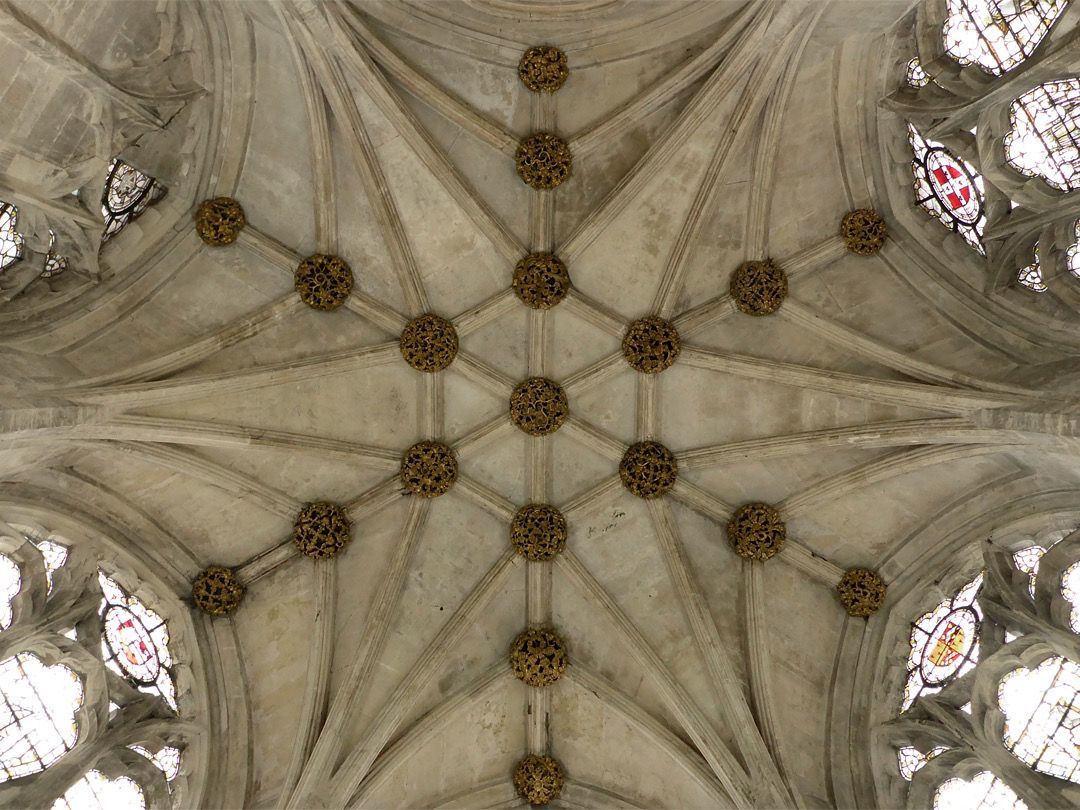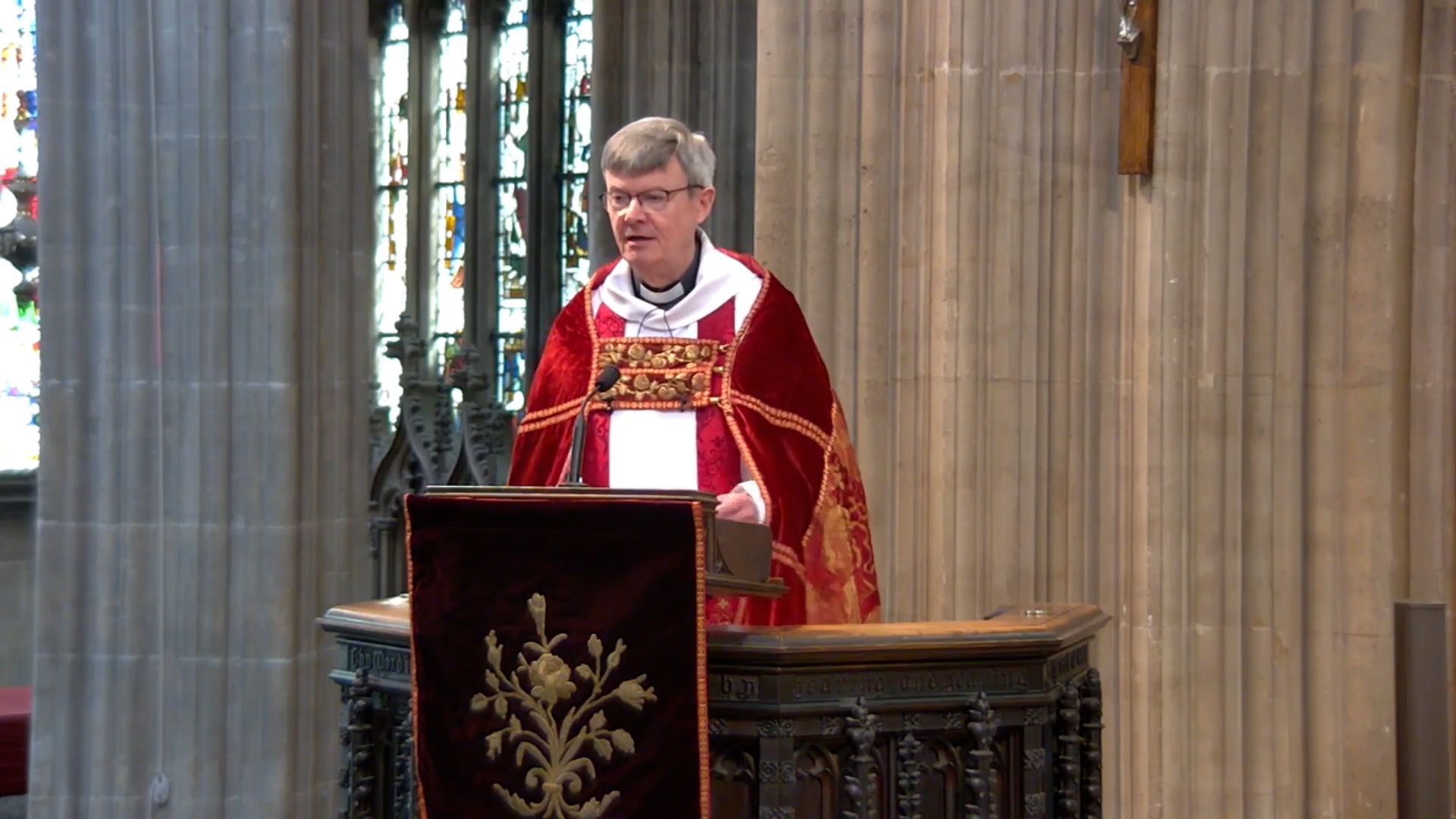The North Porch
"A Romance in Stone"
The North Porch, which was built between the late C12th and early C14th, is one of the most significant parts of the church. It was considered its “principal chapel” in the C15th and is known to have contained a devotional statue of the Virgin Mary. The Inner North Porch is one of the oldest parts of the building, dating from around 1185-1200, while the Outer North Porch - one of only three hexagonal porches in England and by far the largest - dates from around 1325.
Form
This unusual configuration of a later porch in front of an earlier porch is significant and has been the subject of study by Dr Helen Lennon who recently presented a Redcliffe Talk on the subject. For Dr Lunnon, the decision to build the newer outer porch in front of the older inner porch is a realisation of scriptural references relating to Solomon's temple:
Regardless of the new building’s plan type, the decision taken not to demolish the existing porch is critical. The dissimilarity between the forms of the two structures is such that they cannot be read as a double-depth porch—the independent identity of each building is retained. As a result, the north elevation of St Mary Redcliffe effectively has two porches, one built before (in front of) the other; a patent fourteenth-century realization of the passage “et alteram porticum in facie maioris porticus” (“and another porch before the greater porch”; 1 Kings 7:6) The arrangement at Redcliffe suggests a particular reading of this biblical passage. It encourages maioris to be understood in the sense of bestowing honour and esteem, specifying not that the porch is of great size but rather of great distinction and venerability. As the container of a cult statue of the Mother of God, the inner porch was an august, respected place and served the designer well in his architectural translation of the text. The porch of around 1200 was preserved in order to serve the new architectural composition.
Excerpt from Inventio Porticus—Imagining Solomon’s Porches in Late Medieval England by Dr Helen Lennon
The main entrance to the Outer North Porch is unusual and is reminiscent of eastern design. John Britton in his early C19th monograph, An Historical and Architectural Essay Relating to Redcliffe Church, Bristol (1813) wrote:
Externally and internally this porch consists of two principal tiers, or stories, each dissimilar to the other, and each adorned with niches, canopies, crockets, pediment , etc. The grand doorway is a curiosity in architecture; being unlike any other, I believe, in this country.. It has some analogy, in form and ornament, to one in the monastery of Batalha, in Portugal, which was designed by David Hacket, an Irishman, about 1400.
Stone carvings
While many of the larger statues that would have adorned the outside of the porch have been lost, probably during the turbulent 16th and 17th centuries that witnessed unprecedented destruction during the English Reformation and the Civil War, the porch remains rich in intricate stone carvings, both inside and on the exterior.
Many of the external carvings are replicas that were created during the major Victorian restoration of the church. However, some of the original medieval corbels survive and can be seen in the south transept of the church. Look out for the corbels in the form of fantastic beasts and animals at ground level on the outside of the porch, and the frieze work above head height inside the Outer Porch that contains medieval characters and comical rustic scenes.
The Chatterton Room
There are two rooms above the North Porch: the Muniment or Chatterton Room, above the Outer Porch and a small room above the Inner Porch that may have been used a a priest's chamber of cell during the medieval era.
By far the most famous is the Chatterton Room, through its association with the poet, Thomas Chatterton (20 November 1752 – 24 August 1770).
St Mary Redcliffe Church provided the primary inspiration for Thomas Chatterton, from its magnificent Gothic architecture to its memorials to Bristol’s dignitaries. He wrote about the church in his quasi-medieval poems and prose, and he also composed modern poems, satires and social sketches.
Chatterton was born in the writing-master’s house of Pile Street School just a stone’s throw from St Mary Redcliffe Church. His father, the writing-master, sadly died before Chatterton himself was born, but among his belongings were various medieval documents (considered worthless) he had rescued from a chest in the muniments room above the north porch of the church. It is thought that these ancient documents encouraged Chatterton to imitate medieval language and literature which he attributed to a fifteenth century monk, Thomas Rowley.
Chatterton’s fictional Thomas Rowley was portrayed as a friend of William Canynges (1399-1474) benefactor of Saint Mary Redcliffe and five times Mayor of Bristol. Chatterton presented his poems, some inscribed onto genuine ancient parchments, as if they were actual antiquities. Although close scrutiny of the poems by antiquarians of the time pronounced them to be modern, few believed that they could be the work of a mere fifteen-year-old boy.
So it was that, after his untimely early death, there was a fierce literary controversy over the authorship of the work. After years of dispute, the Rowley poems were accepted as the work of Thomas Chatterton, and it is upon this work, as well as his satirical verse and anti-slavery poems, that Chatterton’s literary legacy now rests.
Chatterton had a huge influence on the subsequent Romantic movement - inspiring writers such as Blake, Wordsworth, Coleridge, Southey, Shelley, Keats, Rossetti, Browning and Wilde during the nineteenth century, as well as visual artists, such as the Pre-Raphaelites.
Listen to a reading of one of Chatterton's poems about St Mary Redcliffe below.
C19th restoration
By the C19th century the church had fallen into a state of disrepair
Glossary
Corbel: In architecture, a corbel is a structural piece of stone, wood or metal jutting from a wall to carry a superincumbent weight, a type of bracket.
Further reading
St Mary Redcliffe's North Porch Historical Gazetteer Jon Cannon (2015)
Inventio Porticus—Imagining Solomon’s Porches in Late Medieval England Dr Helen Lunnon (2017)
An Historical and Architectural Essay Relating to Redcliffe Church John Britton (1813)



